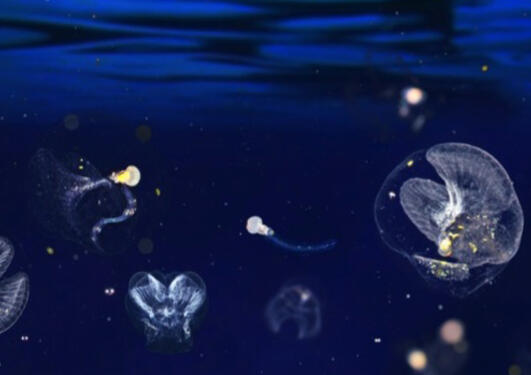Michael Sars Centre Appendicularian facility featured in a short documentary
Head engineer Anne Aasjord collaborated with researchers at NORCE on a project to better understand the ecological relevance of the small planktonic animals. The work was recently highlighted in a documentary, watch it below!

Main content
Forskere på sporet av ny sammenheng mellom halesekkdyr og marine virus.
Appendicularians are one of the most abundant planktonic animals found in the oceans. Using their ‘house’, which contains an elaborate filtering system, the tadpole-shaped organisms collect food particles from the water. On the menu: algae, bacteria, and large viruses. Could grazing by filter-feeders such as the appendicularian Oikopleura dioica help explain the distribution of viruses in the oceans?
To answer this question, researchers Aud Larsen, Jessica Louise Ray, Kyle Mayers and their colleagues at NORCE spearheaded the VIROVAC project between 2018 and 2021. Anne Aasjord, head engineer in the Michael Sars Centre’s Appendicularian facility, contributed her unique expertise in collecting and culturing the animals. As part of the project, the researchers shared their work in the laboratory and in the field in a documentary.
“It was great to have the opportunity to show the animals, how we keep them in the lab and how useful they are for research, that’s what I’m most proud of”, said Aasjord of her participation. “It is important to me to share what I do with the public.”
Researcher Kyle Mayers explains in the film that the appendicularians’ fast digestion rate, as well as their habit of shedding their house every few hours, could lead to the transfer of live viruses from the water column to the sea floor. The project has now concluded, and his hypothesis turned out to be correct. “We found that appendicularians were able to eat all of the large viruses we tested, and that there was infectious virus in their fecal pellets”, he explained. “Out in the fjords around Bergen, we also found infectious viruses in the sediments, suggesting this mechanism might be how the viruses are making it down to the seafloor!”
Sharing the work with the public through a documentary was an integral part of the project from the start. Through this format of science dissemination, Research Group Leader Aud Larsen hopes to raise awareness of the smaller inhabitants of the oceans. “I would like for people that do not normally think of smaller organisms in the ocean to get aware of their importance – and beauty – and get excited to learn more.”
The film is produced by Ingvill Warholm / Warholm Film AS warholmfilm.no ©
In collaboration with NORCE.


